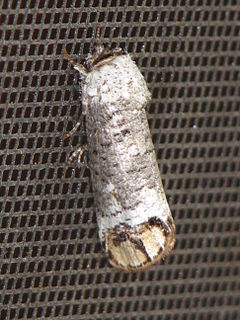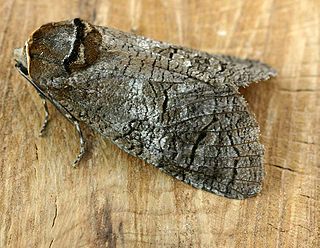
The Cossidae, the cossid millers or carpenter millers, make up a family of mostly large miller moths. This family contains over 110 genera with almost 700 known species, and many more species await description. Carpenter millers are nocturnal Lepidoptera found worldwide, except the Southeast Asian subfamily Ratardinae, which is mostly active during the day.
Nadagara is a genus of moths in the family Geometridae first described by Francis Walker in 1861.

Polyphagozerra coffeae, the red coffee borer or coffee carpenter, is a moth of the family Cossidae. It was described by John Nietner in 1861 and is found in Asia. Records from the Moluccas and New Guinea refer to Polyphagozerra reticulata, which was previously considered to be a synonym of P. coffeae. It is a widespread pest that attacks many plants.

Dyspessa is a genus of moths belonging to the family Cossidae. It was described by Jacob Hübner in 1820.

Xyleutes is a genus of moths belonging to the family Cossidae.

Cossus is a genus of moths in the family Cossidae described by Johan Christian Fabricius in 1793.
Semagystia wernerithomasi is a moth in the family Cossidae. It was described by Yakovlev in 2007. It is found in Afghanistan and Kazakhstan.

The Zeuzerinae are a subfamily of the family Cossidae.
Afroarabiella is a genus of moths in the family Cossidae.
Paracossus is a genus of moths in the family Cossidae.
Roepkiella is a genus of moths in the family Cossidae.

Chalcidica minea is a moth in the family Cossidae. It is found in India, Vietnam, Thailand, the Moluccas, Papua New Guinea, Queensland and on the Solomon Islands. The habitat consists of lowland rainforests.
Rapdalus is a genus of moths in the family Cossidae.
Tarsozeuzera is a genus of moths in the family Cossidae.
Panau is a genus of moths in the family Cossidae.
Sansara is a genus of moths in the family of Cossidae.
Roepkiella thaika is a moth in the family Cossidae. It was described by Yakovlev in 2006. It is found in southern Thailand and Vietnam.
Sansara pallidalae is a moth in the family Cossidae. It was described by George Hampson in 1892. It is found in Bhutan and Sikkim, India.
Orientozeuzera postexcisa is a moth in the family Cossidae. It was described by George Hampson in 1893. It is found in Sri Lanka and possibly southern India.
Tarsozeuzera fuscipars is a moth in the family Cossidae. It was described by George Hampson in 1892. It is found in southern India, Malaysia, Borneo, Vietnam, Thailand and Yunnan, China.







